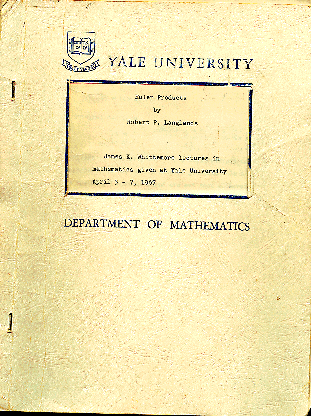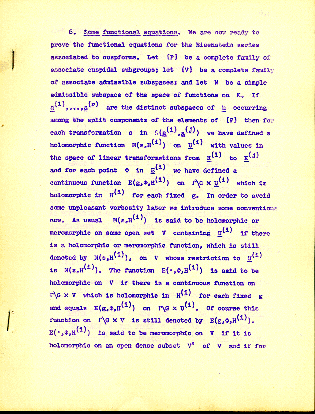

|
This appeared in the proceedings of the 1965 AMS Boulder conference.  The paper
The paper
This appeared in the proceedings of the 1965 AMS Boulder conference.  The book
The book

The letter to Weil included a number of striking conjectures which eventually changed much of the direction of research in automorphic forms. Some of their consequences were explained in a graduate course given at Princeton in the spring of 1967, and then things were put in a somewhat wider context in a series of lectures at Yale later that Spring. These notes were previously published as the first of the Yale Mathematical Monographs.  The notes
The notes
Langlands' comments:
The formula (6), which is established in sufficient generality to verify
the convergence of the Euler products, is not established in general, although it is
surmised that it is generally true. This was, indeed, proved a little later in
complete generality and, so far as I know, quite independently by
Ian MacDonald (Spherical functions on a group of The formula referred to as the formula of Gindikin-Karpelevich was, indeed, proved in general by them, but had first been discovered by Bhanu-Murty and proved by him for the special linear group over R in

Although the notes for the lectures were available as a preprint at the time they were delivered or shortly thereafter, the monograph did not appear until 1970. Apart from the addition of one or two footnotes and the correction of misprints and slips of the pen, there were no alterations.
Gelbart and Shahidi have written a useful survey
of the theory of automorphic
The letter to Weil that saw the birth
of the L-group was written in January, 1967.
Somewhat later that same year, Roger Godement asked Langlands to comment on
the Ph. D. thesis of Hervé Jacquet. His reply included a number
of conjectures on Whittaker functions for both real and
 The letter
The letter
Langlands' comments:
The notation may cause the reader some difficulties.
Some symbols, for example References to pages either in Jacquet's thesis or in the handwritten letter have been allowed to stand. The formula for Whittaker functions for unramified representations suggested in the letter was proved by Casselman and Shalika. It appears from the Institute records that Godement visited Princeton early in March of 1967. It must have been then that I spoke to him. The lectures at Yale were given early in April of 1967 and appeared later as the monograph Euler Products (included just above). 
This was written in 1965 and distributed for many years in a famous purple mimeographed document by the Yale University Mathematics Department. It was later published in the Springer Lecture Notes series (volume #544).  The paper
The paper
This originally appeared as a
supplement to an article by A. Borel and H. Jacquet
in Automorphic forms, representations, and  The paper
The paper
This first appeared in a volume of Israel Mathematical Conference Proceedings 3 (1990) dedicated to Ilya Piatetski-Shapiro.  The paper
The paper
|